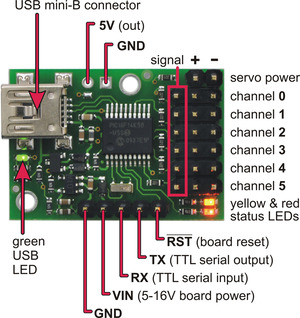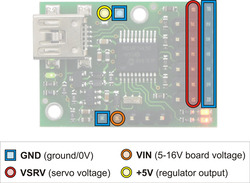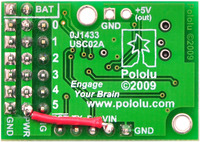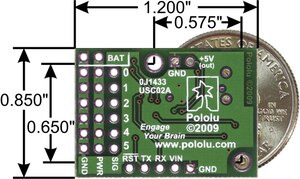Support » Pololu Maestro Servo Controller User’s Guide » 1. Overview »
1.a. Micro Maestro Pinout and Components
 |
Micro Maestro 6-channel USB servo controller (fully assembled) labeled top view. |
|---|
Note: This section applies to the Micro Maestro servo controller. Please see Section 1.b for Mini Maestro pinout and component information.
The Pololu Micro Maestro 6-channel servo controller can connect to a computer’s USB port via a USB A to mini-B cable (not included). The USB connection is used to configure the servo controller. It can also be used to send commands to the servo controller, get information about the servo controller’s current state, and send and receive TTL serial bytes on the TX and RX lines.
 |
Micro Maestro power pins. |
|---|
The processor and the servos can have separate power supplies.
Processor power must come either from USB or from an external 5–16V power supply connected to the VIN and GND inputs. It is safe to have an external power supply connected at the same time that USB is connected; in such cases the processor will be powered from the external supply. Note that if the external supply falls below 5 V, correct operation is not guaranteed, even if USB is also connected.
Servo power connections are provided in the upper right corner of the Micro Maestro board. Servo power is passed directly to the servos without going through a regulator, so the only restrictions on your servo power supply are that it must be within the operating range of your servos and provide enough current for your application. Please consult the datasheets for your servos to determine an appropriate servo power source, and note that a ballpark figure for the current draw of an average straining servo is 1 A.
 |
Micro Maestro configured to use a single power supply for both board and servos. |
|---|
You can power the Maestro’s processor and servos from a single power supply by connecting the positive power line to both VIN and the servo power ports. An easy way to accomplish this on the Micro Maestro is to solder a wire on the bottom of the board between VIN and one of the servo power connections as shown in the picture to the right. Only one ground connection is needed because all ground pins on the board are connected.
The 5V (out) power output allows you to power your own 5V devices from the on-board 50mA regulator or directly from USB. The on-board regulator is used whenever VIN is powered; in this case, since the Maestro requires 30 mA, there is about 20 mA available to power other devices.
The SIG lines (0, 1, 2, …) are used for sending pulses to servos, controlling digital outputs, and measuring analog voltages. These lines are protected by 220Ω resistors. The total current limit (in or out) for these pins is 60 mA, but when using the on-board regulator the current out is limited to 20 mA (see above.)
The RX line is used to receive non-inverted TTL (0–5 V) serial bytes, such as those from microcontroller UARTs. These bytes can either be serial commands for the Maestro, arbitrary bytes to send back to the computer via the USB connection, or both. For more information about the Maestro’s serial interface, see Section 5.a. Note that the Maestro will probably be able to receive 3.3V TTL serial bytes, but it is not guaranteed to read 3.3V as high on the RX pin, so you should boost 3.3V TTL serial signals to above 4V if you want to ensure reliable operation.
The TX line transmits non-inverted TTL (0–5 V) serial bytes. These bytes can either be responses to serial commands sent to the Maestro, or arbitrary bytes sent from the computer via the USB connection.
The RST pin can be driven low to reset the Maestro’s microcontroller, but this should not be necessary for typical applications. The line is internally pulled high, so it is safe to leave this pin unconnected. Driving RST low is roughly equivalent to powering off the Maestro; it will not reset any of the configuration parameters stored in non-volatile memory. To reset the configuration parameters, select Device > Reset to default settings… in the Maestro Control Center.
 |
Micro Maestro 6-channel USB servo controller bottom view with quarter for size reference. |
|---|
The dimensions of the Micro Maestro PCB are 1.2″ × 0.85″. The mounting holes have a diameter of 0.086″and are intended for #2 or M2 screws. The vertical and horizontal distances between the two mounting holes are 0.65″ and 0.575″. The Micro Maestro weighs 3.0 g (0.11 oz) without header pins.










